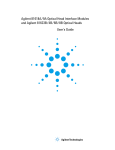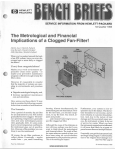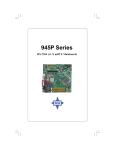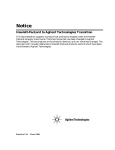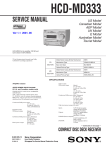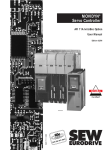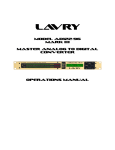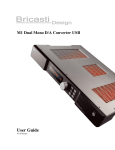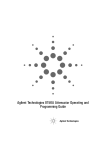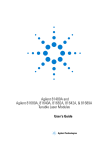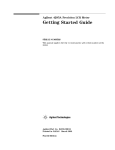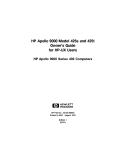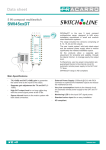Download HP 81531A User's Manual
Transcript
User's Guide HP 81531A Sensor Module SERIAL NUMBERS This manual applies to all instruments. ABCDE HP Part No. 81531-90011 Printed in Germany Second Edition E0796 Control Serial Number: Edition 2 applies directly to all instruments. Edition 1 : 1st May 1990 : 81531-90011 : E0590 1st September 1990 : 81531-90011 : E0990 Edition 2 : 1st September 1991 : 81531-90011 : E0991 1st September 1992 : 81531-90011 : E0992 1st December 1994 : 81531-90011 : E1294 1st July 1996: 81531-90011 : E0796 Safety Considerations Before operation, you should review the instrument and manual, including the red safety page, for safety markings and instructions. You must follow these to ensure safe operation and to maintain the instrument in safe condition. Initial Inspection Inspect the shipping container for damage. If there is damage to the container or cushioning, you should keep it until you have checked the contents of the shipment for completeness and veried the module both mechanically and electrically. The Performance Tests give procedures for checking the operation of the module. If the contents are incomplete, mechanical damage or defect is apparent, or if a moduke does not pass the operator's checks, notify the nearest Hewlett-Packard oce. Warning To avoid hazardous electrical shock, do not perform electrical tests when there are signs of shipping damage to any portion of the outer enclosure (covers, panels, etc.). Power Requirements The HP 81531A operates when installed into the HP 8153A Optical Multimeter mainframe. Operating Environment The HP 8153A safety information summarizes the HP 81531A operating environment ranges. In order for the HP 81531A to meet specications, the operating environment must be within the limits specied in this section. Input/Output Signals iii Caution A maximum of 15V can be applied as an external voltage to any BNC connectors. Storage and Shipment The module can be stored or shipped at temperatures between 040 C and +70 C. The module should be protected from temperature extremes that may cause condensation within it. iv Contents C. HP 81531A Specications Supplementary Performance Characteristics . . . . . . . . . . . Analog output: . . . . . . . . . . . . . . . . . . . . . . . D. Performance Tests Introduction . . . . . . . . . Equipment Required . . . . Test Record . . . . . . . . . Test Failure . . . . . . . . . Instrument Specication . . . Performance Test . . . . . . Accuracy and Linearity Test Test Setup . . . . . . . . I. Accuracy Test . . . . . II. Linearity Test . . . . . III. Noise Test . . . . . . . . . . . . . . . . . . . . . . . . . . . . . . . . . . . . . . . . . . . . . . . . . . . . . . . . . . . . . . D-1 D-1 D-2 D-2 D-2 D-3 D-3 D-3 D-4 D-5 D-8 The Cleaning Kit . . . . . . . . . . . . . . . . . . . . Other Cleaning Tools . . . . . . . . . . . . . . . . . Preserving Connectors . . . . . . . . . . . . . . . . . Cleaning Instrument Housings . . . . . . . . . . . . . Correct Cleaning Procedure . . . . . . . . . . . . . . Cleaning Cable Connectors . . . . . . . . . . . . . . Cleaning Connector Adapters . . . . . . . . . . . . . Cleaning Connector Interfaces . . . . . . . . . . . . How to clean instruments with a recessed lens interface Light dirt . . . . . . . . . . . . . . . . . . . . . Heavy dirt . . . . . . . . . . . . . . . . . . . . . . . . . . . . . . . . . . . . . . . . . . . . . . . . . . . . . . . . . . . . . . . . E-1 E-3 E-4 E-4 E-5 E-5 E-6 E-6 E-7 E-7 E-7 E. Cleaning Procedures . . . . . . . . . . . . . . . . . . . . . . . . . . . . . . . . . . . . . . . . . . . . . . . . . . . . . . . . . . . . . . . . . . . . . . . . . . . . . . . . . . . . . . . . . . . . . . . . . . . . . . . . . . . . . . . . . . . . . . . . . . . . . . . . . . . . C-3 C-3 Index Contents-1 Figures D-1. Accuracy and Linearity Test Setup . . . . . . . . . . . . . . D-2. Addition of results (example) . . . . . . . . . . . . . . . . . Contents-2 D-4 D-7 C C HP 81531A Specications Specications describe the instrument's warranted performance. Supplementary performance characteristics describe the instrument's non-warranted typical performance. Because of the modular nature of the instrument, these performance specications apply only to this module. You should insert these pages into the appropriate section of the manual. HP 81531A Specications C-1 C HP 81531A Specications Sensor Element Wavelength range Power range Display resolution In GaAs 800-1700nm +3 to -90dBm dBm, dB 0.001 0.0001 on printout Watt 0.01 to 10 (depending on power range) Applicable ber type 9/125m - 100/140m, NA0.3 Uncertainty (Accuracy) 62.5% (1000-1650nm)[1] Total Uncertainty 65%61.5pW (1000-1650nm)[2] Linearity (0 to -70dBm) 18 C to 28 C const. temp 60.015dB61pW 0 C to 55 C const. temp 60.05dB61.5pW Noise <1.5pW (1200-1600nm) peak-peak, avg. time 1sec Dimensions 75mm H, 32mm W, 335mm D (2.8"21.3"213.2") Weight net 0.6kg (1.3lbs), shipping 1kg (2.2lbs) Recalibration period 2 years Warmup time 20 min. Information on the traceability of power meters is available on request [1] at the following reference conditions: Power level 10W (-20dBm), Continuous Wave (CW). Fiber 50m graded index, NA=0.2, fully excited. Ambient temperature 23 C65K. Connector Diamond HMS-10/HP. At day of calibration (add 0.3% for aging over one year, add 0.6% over two years). Spectral width of source <10nm. [2] at the following operating conditions: Fiber 50m, NA 0.2. For NA >0.2 add 1%. C-2 HP 81531A Specications C Ambient temperature 0 to 55 C, non-condensing. Within 1 year after calibration, add 0.3% for second year. For Biconic Connector add 61%. Supplementary Performance Characteristics Add 1% to total uncertainty for the full wavelength range. Outside the specied wavelength range, the noise increases by up to 5 times the value shown above. Analog output: Bandwidth: DC, 300 to 400Hz, depending on range and sensor module. Output voltage: 0 to 2V into open. Output impedance: 600 typical. Max. input voltage: 610V. HP 81531A Specications C-3 D Performance Tests Introduction The procedures in this section test the performance of the instrument. The complete specications to which the HP 81531A is tested are given in Appendix C. All tests can be performed without access to the interior of the instrument. The test equipment given corresponds to tests carried out with Diamond HMS-10/HP conectors. Equipment Required Equipment required for the performance test is listed in the table below. Any equipment which satises the critical specications of the equipment given in the table, may be substituted for the recommended models. Instrument/Accessory Recommended Model Power Meter Standard HP 8153A Mainframe with #C01 HP 81533A Optical Head Interface Module with HP 81524A Optical Head Required Characteristics Uncertainty 61.5% Multimeter Mainframe HP 8153A CW Laser Sources HP 81552SM and HP 81553SM or Wavelength HP 81554SM Uncertainty 61.5nm Optical Attenuator HP 8156 Option 101 Connector Adapter (head) HP 81000AA Connector Interface HP 81000AI 4ea (08154-61701) Singlemode Fiber HP 81101AC 2ea Plastic Cap 5040-9351 2ea Performance Tests D-1 D D Test Record Results of the performance test may be tabulated on the Test Record provided at the end of the test procedures. It is recommended that you ll out the Test Record and refer to it while doing the test. Since the test limits and setup information are printed on the Test Record for easy reference, the record can also be used as an abbreviated test procedure (if you are already familiar with the test procedures). The Test Record can also be used as a permanent record and may be reproduced without written permission from Hewlett-Packard. Test Failure If the HP81531A fails any performance test, return the instrument to the nearest Hewlett-Packard Sales/Service Oce for repair. Instrument Specication Specications are the performance characteristics of the instrument which are certied. These specications, listed in Appendix C, are the performance standards or limits against which the HP 81531A can be tested. Appendix C also lists some supplemental characteristics of the HP 81531A. Supplemental characteristics should be considered as additional information. Any changes in the specications due to manufacturing changes, design, or traceability to the National Institute of Standards and Technology (NIST), will be covered in a manual change supplement, or revised manual. Such specications supercede any that were previously published. D-2 Performance Tests Performance Test D The performance test given in this section includes the Accuracy Test, the Linearity Test, and the Noise Test. Perform each step in the order given, using the corresponding test equipment. Note Make sure that all optical connections of the test setups given in the procedure are dry and clean. DO NOT USE INDEX MATCHING OIL. The optical cables from the laser source to and from the HP 8156A Attenuator to the power meter must be xed on the table to ensure minimum cable movement during the tests. Accuracy and Linearity Test Specications Uncertainty : Linearity : HP 81531A 62.8%y (1000-1650nm) 60.015dB61pW y includes aging. Test Setup 1. Make sure that cable connector, detectors and adapters are clean. 2. Connect the equipment as shown in Figure D-1. Ensure that the cables to and from the attenuator are xed on the table and that both the optical head and the DUT are close together so that minimum cable movement is required when connecting the cable to the head or to the DUT. Performance Tests D-3 D Figure D-1. Accuracy and Linearity Test Setup 3. Turn the instruments on, enable the laser source and allow the instruments to warm up for at least 20 minutes. Note The linearity test must only be performed at either 1300nm or 1550nm. The accuracy test must be performed in the -20dBm range at 10W at both 1300nm and 1550nm. I. Accuracy Test 1. On both power meters: a. Set the calibration factor to zero. b. Set the wavelength to the wavelength of the laser source. c. Set the instruments into MEAS mode. Make sure AUTOranging is o and select the -20dBm range. d. Set the averaging time to 500ms. 2. Make sure that the HP 8156A output is disabled. ZERO the DUT. 3. Connect the HP 8156A output cable to the standard head and ZERO the standard meter. 4. Enable the HP 8156A output. Change the HP 8156A attenuation until the power meter standard displays 10.00W. 5. Connect the attenuator output cable to the DUT. Check the DUT display and note the result in the test record. 6. Repeat steps 1 to 5 at the second wavelength with the corresponding source. D-4 Performance Tests II. Linearity Test 1. Make sure that the HP 8156A output is disabled. ZERO the DUT. 2. Enable the HP 8156A output. 3. On the DUT, switch o autoranging and select the -20dBm range. Set the display to show results in dBm. 4. Alter the attenuation until the DUT displays -17.4dBm. 5. Press 4Disp!Ref5, then 4dB5. 6. Press 4Up5 to select the -10dBm range. 7. Note the deviation, displayed in dB, as R1 on the test record. a. In the -10dBm range. Set the display to show results in dBm. b. Alter the attenuation until the DUT displays -7.4dBm. c. Press 4Disp!Ref5, then 4dB5. d. Select the 0dBm range. e. Note the deviation, displayed in dB, as R2 on the test record. 8. Repeat the steps a to e at all the range and level settings shown in the test record. 9. Calculate the non-linearity using the formulae in the test record. Performance Tests D-5 D Example Results for the Linearity test D Test Minimum Maximum Measurement No. Test Description Spec. Result Spec. Uncertainty II. Linearity Test dB Range Power (dBm) -20dBm -17.4 Disp!Ref -10dBm 0.004 =R1 -10dBm 0dBm -7.4 Disp!Ref -20dBm -30dBm -27.4 Disp!Ref -30dBm -40dBm -37.4 Disp!Ref -40dBm -50dBm -47.4 Disp!Ref D-6 Performance Tests -0.008 =R2 -0.008 =R3 -0.004 =R4 0.02 =R5 Example Calculated Results for the Linearity Test Test No. Test Description Non-Linearity Range Minimum Spec. Result Maximum Measurement Spec. Uncertainty Formula 0dBm R1+R2 -0.015dB -0.004dB +0.015dB 60.006dB -10dBm R1 -0.015dB 0.004dB +0.015dB 60.006dB -20dBm 60.00dB 0.000dB -30dBm R3 -0.015dB -0.008dB +0.015dB 60.006dB -40dBm R3+R4 -0.015dB -0.012dB +0.015dB 60.008dB -50dBm R3+R4+R5 -0.015dB 0.008dB +0.015dB 60.010dB Shown graphically, these results look as shown in the following gure: Figure D-2. Addition of results (example) Performance Tests D-7 D D III. Noise Test Note The noise measurement must be performed with either a module or a blank panel in the second channel position. Connect the equipment as shown in Figure D-1. Disable the HP 8156A output. On the DUT, select AUTOranging, and display in Watts. Set the averaging time to 1s. Press 4Zero5. Select the MENU mode. Press 4Record5, to select Stability. Press 4Edit5 and select the T_TOTAL parameter. Set T_TOTAL to 1 minute. Press 4Edit5, and then 4Exec5 to run the noise measurement. When the test has completed, press 4More5 to select the SHOW application. Press 4Edit5 and then 4Next5/4Prev5 to display the DIFF result. Note the DIFF result as the noise value in the test record. D-8 Performance Tests Performance Test for the HP 81531A Page 1 of 4 Test Facility: Report No. Date Customer Tested By Model HP81531A Sensor Module Serial No. Ambient temperature C Options Relative humidity % Firmware Rev. Line frequency Hz Special Notes: Performance Tests D-9 D Performance Test for the HP 81531A D Page 2 of 4 Test Equipment Used: Description Model No. 1. Lightwave Multimeter (Std.) HP 8153A 2. Opt. Head Interface Module HP 81533A 3. Optical Head HP 81524A 4a1. CW Laser Source HP 81552SM 4a2. CW Laser Source HP 81553SM 4b. CW Laser Source HP 81554SM 5. Optical Attenuator Trace No. Cal. Due Date 6. Lightwave Multimeter (DUT) HP 8156A Opt.101 HP 8153A 7. Connector Interface HP 81000AI N/A N/A 8. Connector Adapter HP 81000AA N/A N/A 9. Singlemode Fiber (2ea) HP 81101AC N/A N/A 12. 13. 14. 15. 16. 17. 18. D-10 Performance Tests Performance Test for the HP 81531A Model HP 81531A Sensor Module Test No. Test Description I. Accuracy Test No. Minimum Spec. Date Result W Page 3 of 4 Maximum Measurement Spec. Uncertainty measured at nm Output Power 9.72W 10.28W 62% measured at nm Output Power 9.72W 10.28W 62% II. Linearity Test Range Power (dBm) -20dBm -17.4 Disp!Ref -10dBm -10dBm 0dBm -7.4 Disp!Ref -20dBm -30dBm -27.4 Disp!Ref -30dBm -40dBm -37.4 Disp!Ref -40dBm -50dBm -47.4 Disp!Ref dB =R1 =R2 =R3 =R4 =R5 Performance Tests D-11 D Performance Test for the HP 81531A D Model HP 81531A Sensor Module No. Test Minimum No. Test Description Spec. Result Non-Linearity Range Page 4 of 4 Date Maximum Measurement Spec. Uncertainty Formula 0dBm R1+R2 -0.015dB dB +0.015dB 60.006dB -10dBm R1 -0.015dB dB +0.015dB 60.006dB -20dBm 0.000dB 0.00dB -30dBm R3 -0.015dB dB +0.015dB 60.006dB -40dBm R3+R4 -0.015dB dB +0.015dB 60.008dB -50dBm R3+R4+R5 -0.015dB dB +0.015dB 60.010dB III. Noise Test pW <1.5pW D-12 Performance Tests E Cleaning Procedures E The Cleaning Kit A full cleaning kit contains the following items: Isopropyl alcohol This is usually available from pharmaceutical suppliers or chemists. If possible, use alcohol supplied for medical purposes, rather than impure alcohol or alcohol with additives. Caution Do not use other solvents as some can damage plastic materials and claddings. For example, Acetone dissolves the adhesives used in ber optic devices. Warning Never drink this alcohol as this can lead to blindness or other serious damage to your health. Cotton-swabs Use swabs such as Q-tips or other cotton-swabs. These are typically available from local distributors of medical or hygiene products (such as supermarkets or pharmacies). Note If you are cleaning connector interfaces or adapters, the diameter of the cotton swab is important. Cotton swabs for babies normally have a smaller diameter. Caution Do not use foam swabs, as these can leave lmy deposits on the surface you are cleaning. Store your cotton-swabs carefully and never reuse them. Dust and dirt from the air or from previous cleaning, can scratch or dirty your optical device. Soft-tissues These are available from most stores and distributors of medical and hygiene products (such as supermarkets or pharmacies). Use multi-layer tissues made from non-recycled cellulose. These are more absorbent and softer than other types and they do not scratch the surface of your device. Caution Store your soft-tissues carefully and never reuse them, as dust and dirt from the air or from previous cleaning can scratch and dirty your optical device. Cleaning Procedures E-1 Pipe-cleaner E Compressed Air This is available from tobacco shops. Ensure that the bristles of the pipe-cleaner are soft, so that they do not scratch your device during cleaning. Caution Store your pipe-cleaners carefully and never reuse them as dust and dirt from the air or from previous cleaning can scratch and dirty your optical device. This is available from laboratory suppliers. It is essential that your compressed air is free of dust, water and oil. Only use clean, dry air. If you do not, it can lead to lmy deposits or scratches. When using compressed air from a can, Hold the can upright. A slant can cause propellant to escape with the compressed air and dirty your optical device. Spray the rst couple of seconds into the air, as the rst stream of compressed air can contain condensation or propellant. Any condensation produces a lmy deposit. If you are using compressed air from a can, you should select one with a CFC-free propellant, for the sake of the environment. E-2 Cleaning Procedures Other Cleaning Tools To examine devices you also require: Microscope Select a microscope with a magnication range of between 50X and 300X. These should be available from photographic stores or laboratory suppliers. Ensure that the light source of the microscope is exible. This helps you to examine your device closely and from dierent angles. A microscope allows you to determine the type of dirt on your device and its extent. Then you can choose the correct cleaning procedure and later to examine the results of cleaning. With a microscope you can also determine if your optical device is scratched. Ultrasonic bath This is typically available from photographic stores or laboratory suppliers. An ultrasonic bath very gently removes greasy and other stubborn dirt from optical devices. Only use an ultrasonic bath with isopropyl alcohol, as other solvents can damage or dirty your optical device. Warm water and Use water only if you are sure that your optical device will not corrode or be liquid soap damaged. Do not use hot water, as this can lead to mechanical stress that can damage your optical device. Ensure that your liquid soap has no abrasive properties or perfume in it, as these can scratch or damage your optical device. Do not use normal washing-up liquid, as it can leave behind an iridescent lm. Premoistened These are available from HP. The part number is HP 92193N (80 Wipes per cleaning wipes box). These are tissues that are moistened with isopropyl alcohol. Polymer lm This is typically available from professional photographic stores or laboratory suppliers. Polymer lm is very gentle on optical surfaces and is particularly good for cleaning extremely sensitive devices such as mirrors. Infrared sensor This is typically available from laboratory suppliers. card With this card you can qualitatively check the uniformity of your emitted laser light, because when the laser light is projected onto the sensor card it becomes visible. Some lens cleaning papers and cleaning kits available, for example, in Lens Cleaning photographic stores are not suitable for cleaning ber optic devices. To be sure, Paper please ask the salesperson or the manufacturer. Cleaning Procedures E-3 E Preserving Connectors E Listed below are some hints on how to keep your connectors in the best possible condition. Making Before you make any connection you must ensure that all cables and Connections connectors are clean. If they are dirty, use the appropriate cleaning procedure. When inserting the ferrule of a patchcord into a connector or an adapter, make sure that the ber end does not touch the outside of the mating connector or adapter. Otherwise you will rub the ber end against an unsuitable surface, producing scratches and dirt deposits on the surface of your ber. Dust Caps and Be careful when replacing dust caps after use. Do not press the bottom of the cap onto the ber as any dust in the cap can scratch or dirty your ber surface. Shutter Caps When you have nished cleaning, put the dust cap back on, or close the shutter cap if the equipment is not going to be used immediately. Keep the caps on the equipment always when it is not in use. All of Hewlett-Packard's lightwave instruments and accessories are shipped with either laser shutter caps or dust caps. If you need additional or replacement dust caps, contact your Hewlett-Packard sales oce. Immersion Oil Where it is possible, do not use immersion oil or other index matching and Other Index compounds with your device. They are liable to impair and dirty the surface of the device. In addition, the characteristics of your device can be changed and Matching your measurement results aected. Compounds Cleaning Instrument Housings Use a dry and very soft cotton tissue to clean the instrument housing and the keypad. Do not open the instruments as there is a danger of electric shock, or electrostatic discharge. Opening the instrument can cause damage to sensitive components, and in addition your warranty will be voided. E-4 Cleaning Procedures Correct Cleaning Procedure If you are unsure about the correct cleaning procedure for your device or if you are unsure whether the procedure given here is suitable for your device, check with the manufacturer or sales distributor, or try the procedure on a dummy or test device rst. E Cleaning Cable Connectors Cleaning connectors is dicult as the core diameter of a singlemode ber is only about 9m. This generally means you cannot see streaks or scratches on the surface. To be certain of the condition of the surface of your connector and to check it after cleaning, you need a microscope. In the case of scratches, or of dust that has been burnt onto the surface of the connector, you may have no option but to polish the connector. This depends on the degree of dirtiness, or the depth of the scratches. This is a dicult procedure and should only be performed by skilled personnel, and as a last resort as it wears out your connector. Warning Never look into the end of an optical cable that is connected to an active source. To assess the projection of the emitted light beam you can use an infrared sensor card. Hold the card approximately 5 cm from the output of the connector. The invisible emitted light is projected onto the card and becomes visible as a small circular spot. Preferred 1. Clean the connector by rubbing a new, dry cotton-swab over the surface Procedure using a small circular movement. 2. Blow away any remaining lint with compressed air. Procedure for Use this procedure particularly when there is greasy dirt on the connector: Stubborn Dirt 1. Moisten a new cotton-swab with isopropyl alcohol. 2. Clean the connector by rubbing the cotton-swab over the surface using a small circular movement. 3. Take a new, dry soft-tissue and remove the alcohol, dissolved sediment and dust, by rubbing gently over the surface using a small circular movement. 4. Blow away any remaining lint with compressed air. An Alternative The better, more gentle, but more expensive cleaning procedure is to use an Procedure ultrasonic bath with isopropyl alcohol. 1. Hold the tip of the connector in the bath for at least three minutes. 2. Take a new, dry soft-tissue and remove the alcohol, dissolved sediment and dust, by rubbing gently over the surface using a small circular movement. 3. Blow away any remaining lint with compressed air. Cleaning Procedures E-5 Cleaning Connector Adapters E Caution Some adapters have an anti-reection coating on the back to reduce back reection. This coating is extremely sensitive to solvents and mechanical abrasion. Extra care is needed when cleaning these adapters. Preferred 1. Clean the adapter by rubbing a new, dry cotton-swab over the surface using a small circular movement. Procedure 2. Blow away any remaining lint with compressed air. Procedure for Stubborn Dirt Use this procedure particularly when there is greasy dirt on the adapter: 1. Moisten a new cotton-swab with isopropyl alcohol. 2. Clean the adapter by rubbing the cotton-swab over the surface using a small circular movement. 3. Take a new, dry soft-tissue and remove the alcohol, dissolved sediment and dust, by rubbing gently over the surface using a small circular movement. 4. Blow away any remaining lint with compressed air. Cleaning Connector Interfaces Caution Be careful when using pipe-cleaners, as the core and the bristles of the pipe-cleaner are hard and can damage the interface. Do not use pipe-cleaners on optical head adapters, as the hard core of normal pipe cleaners can damage the bottom of an adapter. Preferred 1. Clean the interface by pushing and pulling a new, dry pipe-cleaner into the Procedure opening. Rotate the pipe-cleaner slowly as you do this. 2. Then clean the interface by rubbing a new, dry cotton-swab over the surface using a small circular movement. 3. Blow away any remaining lint with compressed air. Procedure for Use this procedure particularly when there is greasy dirt on the interface: Stubborn Dirt 1. Moisten a new pipe-cleaner with isopropyl alcohol. 2. Clean the interface by pushing and pulling the pipe-cleaner into the opening. Rotate the pipe-cleaner slowly as you do this. 3. Moisten a new cotton-swab with isopropyl alcohol. 4. Clean the interface by rubbing the cotton-swab over the surface using a small circular movement. 5. Using a new, dry pipe-cleaner, and a new, dry cotton-swab remove the alcohol, any dissolved sediment and dust. 6. Blow away any remaining lint with compressed air. E-6 Cleaning Procedures How to clean instruments with a recessed lens interface Light dirt If you nd any particles of dirt on the xed connector interface, or on the input of the optical block, clean them with compressed air. This cleaning method is gentle to your optical device and is an ideal approach if there is no fat on the surface of your device. Heavy dirt Using compressed air, blow away larger particles of dirt. Clean the recessed lens interface with a dry cotton swab by rubbing gently over its surface. Then blow away any remaining laments left by the swab. Isopropyl alcohol should only be used if there is fat on the lens. In this case, choose a new swab and moisten it with alcohol. Remove the dirt by gently rotating the swab using light pressure. Then select a fresh, dry swab to wipe away the alcohol. Blow away any remaining lament with compressed air. Caution Do not press the swabs too hard onto the optical surface of your device, as this may produce scratches and your recessed lens could be misaligned. Alcohol will dissolve some types of dirt. If this then forms a deposit on the edge of the optical input it cannot be removed. You should therefore only use alcohol if absolutely necessary. Other solvents, like Acetone, should also not be used, as they may damage your optical device and reduce its performance. Cleaning Procedures E-7 E































